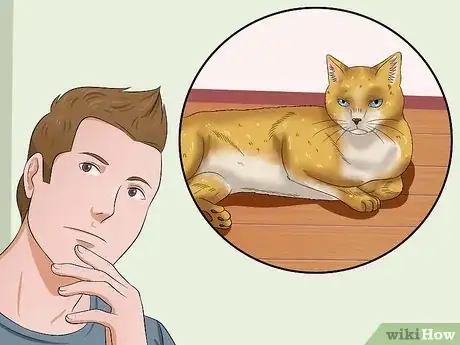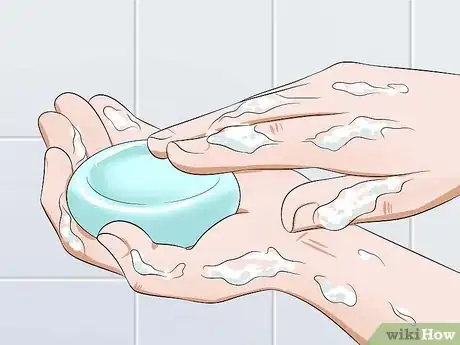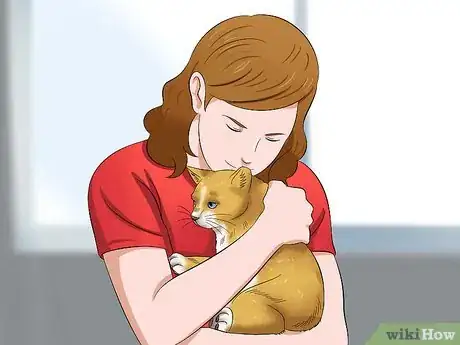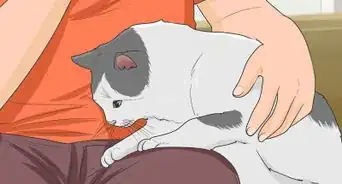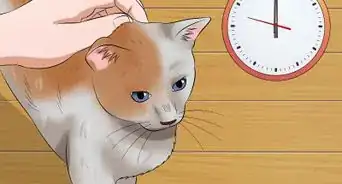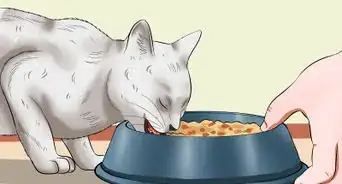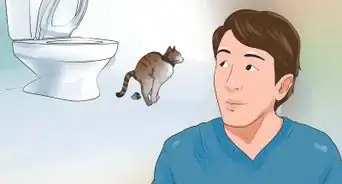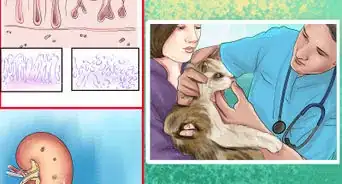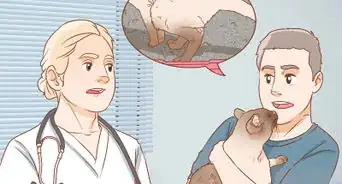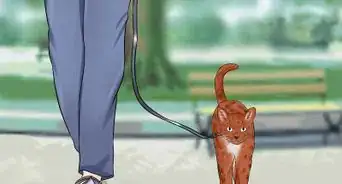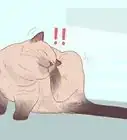This article was co-authored by Pippa Elliott, MRCVS. Dr. Elliott, BVMS, MRCVS is a veterinarian with over 30 years of experience in veterinary surgery and companion animal practice. She graduated from the University of Glasgow in 1987 with a degree in veterinary medicine and surgery. She has worked at the same animal clinic in her hometown for over 20 years.
This article has been viewed 152,589 times.
Express your human-feline bond in a caring and sharing way with a hug. Provided your cat is used to being handled by you and doesn't mind getting close, hugging your cat can be a great way to show affection.
Steps
Understanding Your Cat
-
1Get to know your cat's temperament. Before attempting to hug your cat, get to know your cat's temperament. Not all cats enjoy a lot of physical contact and could scratch or bite if hugged. Make sure your cat is the affectionate type before attempting a hug.
- Spend time with your cat. Spend an hour or so a day in the same room as your cat. Pay attention to how she interacts with you. Does she tend to be snuggly and affectionate, rubbing her face on you? Or does she tend to be somewhat standoffish, sitting near you but not wanting much physical affection?[1]
- Cats that are more touchy-feely tend to be more relaxed about being picked up and handled. It's probably safe to try and hug a friendlier cat, but one that seems standoffish or shy may dislike being handled in this fashion.[2]
-
2Learn about cat body language. Even a warm and affectionate cat will lash out when frightened. Take some time to learn about cat body language so you can gauge when a cat is in a positive mood.
- When cats are happy, they show it with their body. Ears are generally forward slightly, pupils constricted with eyes half closed, tails straight up and curled on the top, and backs arched with fur flattened. Cats will also purr or meow quietly when happy to see you.[3]
- Conversely, an aggressive or frightened cat will growl or meow loudly in a lower pitch. She will dilate her pupils, thrash her tail back and forth or tuck it between her legs, and arch her back and stick her fur up. You should not try to hug a cat in this state.[4]
Advertisement -
3See how your cat responds to being picked up. Even friendly and affectionate cats might resist being picked up. Cats tend to be more independent animals and often resist feeling confined. However, cats who've lived with young children are often used to be carried around and will allow it. If a cat does not like being held, she might thrash or squirm in your arms. You might still be able to hug a cat who dislikes being picked up, but you'll have to do so without holding her.[5]
Hugging Your Cat
-
1Wash your hands. You should always wash your hands before hugging or petting a cat. You want to make sure your hands are free of any irritants that could upset your cat.
- Wet your hands with clean water and lather with soap. Make sure to lather between your fingers, behind your fingernails, and the backs of your hands. Spend about 20 seconds lathering. It can help to sing the "Happy Birthday" song twice to keep track of time.[6]
- Rinse your hands under water. Dry them with a clean towel.[7]
-
2Allow your cat to come to you. You should never sneak up a cat to hug her. You should also not bother your cat when she's sleeping, playing, or eating. Allow your cat to come to you. Sit in the same room as your cat and wait until she decides she wants your attention. When your cat comes up to you and begins purring and pawing at you, it's safe to hug her.
-
3Pet your cat first. Do not go straight into the hug. This can be jarring for a cat. Spend a few moments petting your cat before hugging her.
- Pet your cat on the back, shoulders, under the chin, and behind the ears. Cats tend to dislike being touched on the stomach or sides, as these are vulnerable areas.
- Talk to your cat in a calming, gentle voice so she's relaxed.
-
4Hug your cat. Once your cat seems calm and happy, you can try to hug her. Do so slowly and if your cat seems aggravated stop.
- Some cats might jump up on your chest if you stand in front of them. If your cat does this, try leaning down and see if she puts her hands up on your shoulders. Then, gently lift her towards your chest by raising her back legs with one hand and holding her back in place with the other.
- Remember, not all cats like being picked up. If your cat resists being held, try hugging her by just putting your arms around her when she's sitting or lying down by her. Many cats that dislike being picked up enjoy these kinds of hugs.
- Cats prefer different hugging techniques depending on their personalities. However, almost all cats prefer their full body be supported during a hug. Make sure her bottom legs are supported. Try to keep one hand on her chest or back and another supporting her back legs.[8]
Showing Affection in Other Ways
-
1Brush your cat. Cats enjoy being brushed. It helps keep their fur free of dirt and debris. Cats also may enjoy the sensation of brushing as it itches places they cannot reach with their paws. Hard to reach spots, like the back of your cat's neck or under her chin, might occasionally need a gentle brushing to keep these areas free of mats. You can get a cat brush at a local pet store.[9]
-
2Pet your cat. Most cats enjoy being petted. If your cat dislikes being picked up, you can show affection by petting her each day.
- As always, let your cat come to you. Cats dislike being interrupted while they're doing other things. Cats will show you they want to be petted by gently scratching at your arms, rubbing up against you, and climbing in your lap.
- Make sure to pay attention to where your cat likes to be petted. Some cats have specifics spots on their sides and stomachs they dislike having touched. If your cat growls or shies away, try petting her in a different spot.
-
3Play with your cat. Cats of all ages enjoy playtime. Most cats need 15 to 20 minutes of play time each day.
- Cats enjoy toys that resemble prey they would stalk in the wild. Toys with fake fur and feathers can be a lot of fun for cats. Try attaching a toy mouse to a string or buying a bird toy that comes equipped with a fishing pole like device so you can make the bird "fly."
- Cats tend to be more energetic during the morning hours, so if possible play with your cat when you first wake up.
Expert Q&A
-
QuestionWhat day is National Hug Your Cat Day?
 Pippa Elliott, MRCVSDr. Elliott, BVMS, MRCVS is a veterinarian with over 30 years of experience in veterinary surgery and companion animal practice. She graduated from the University of Glasgow in 1987 with a degree in veterinary medicine and surgery. She has worked at the same animal clinic in her hometown for over 20 years.
Pippa Elliott, MRCVSDr. Elliott, BVMS, MRCVS is a veterinarian with over 30 years of experience in veterinary surgery and companion animal practice. She graduated from the University of Glasgow in 1987 with a degree in veterinary medicine and surgery. She has worked at the same animal clinic in her hometown for over 20 years.
Veterinarian National Hug Your Cat Day is an "unofficial" day that usually takes place on June 4th each year.
National Hug Your Cat Day is an "unofficial" day that usually takes place on June 4th each year. -
QuestionDo cats like to be petted?
 Pippa Elliott, MRCVSDr. Elliott, BVMS, MRCVS is a veterinarian with over 30 years of experience in veterinary surgery and companion animal practice. She graduated from the University of Glasgow in 1987 with a degree in veterinary medicine and surgery. She has worked at the same animal clinic in her hometown for over 20 years.
Pippa Elliott, MRCVSDr. Elliott, BVMS, MRCVS is a veterinarian with over 30 years of experience in veterinary surgery and companion animal practice. She graduated from the University of Glasgow in 1987 with a degree in veterinary medicine and surgery. She has worked at the same animal clinic in her hometown for over 20 years.
Veterinarian Most pet cats that were well-socialized as kittens will greatly enjoy the fuss and attention that comes with petting. However, feral cats or those with limited early life encounters with people will be fearful of people and feel threatened by being petted.
Most pet cats that were well-socialized as kittens will greatly enjoy the fuss and attention that comes with petting. However, feral cats or those with limited early life encounters with people will be fearful of people and feel threatened by being petted. -
QuestionDo cats like to be hugged?
 Pippa Elliott, MRCVSDr. Elliott, BVMS, MRCVS is a veterinarian with over 30 years of experience in veterinary surgery and companion animal practice. She graduated from the University of Glasgow in 1987 with a degree in veterinary medicine and surgery. She has worked at the same animal clinic in her hometown for over 20 years.
Pippa Elliott, MRCVSDr. Elliott, BVMS, MRCVS is a veterinarian with over 30 years of experience in veterinary surgery and companion animal practice. She graduated from the University of Glasgow in 1987 with a degree in veterinary medicine and surgery. She has worked at the same animal clinic in her hometown for over 20 years.
Veterinarian Not all cats do. Be careful to read your cat's body language and only attempt to hug them if they are relaxed, don't struggle, and purr.
Not all cats do. Be careful to read your cat's body language and only attempt to hug them if they are relaxed, don't struggle, and purr.
References
- ↑ http://www.petsafe.net/learn/how-to-hug-your-cat-maybe
- ↑ http://www.petsafe.net/learn/how-to-hug-your-cat-maybe
- ↑ http://www.humanesociety.org/animals/cats/tips/cat_communication.html
- ↑ http://www.humanesociety.org/animals/cats/tips/cat_communication.html
- ↑ http://www.humanesociety.org/animals/cats/tips/cat_communication.html
- ↑ http://www.cdc.gov/features/handwashing/
- ↑ http://www.cdc.gov/features/handwashing/
- ↑ http://www.petsafe.net/learn/how-to-hug-your-cat-maybe
- ↑ http://www.petsafe.net/learn/how-to-hug-your-cat-maybe
About This Article
To hug your cat, wait until it comes up to you or paws at you, which is a sign it wants attention. Then, pet your cat and wait until it's calm. Next, lift your cat up towards your chest, using one hand to support its back, and the other for its back legs. If your cat seems nervous or agitated, try wrapping your arms around it while it's sitting down. For tips on how to read your cat's body language when you're hugging it, read on!
